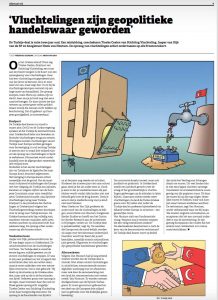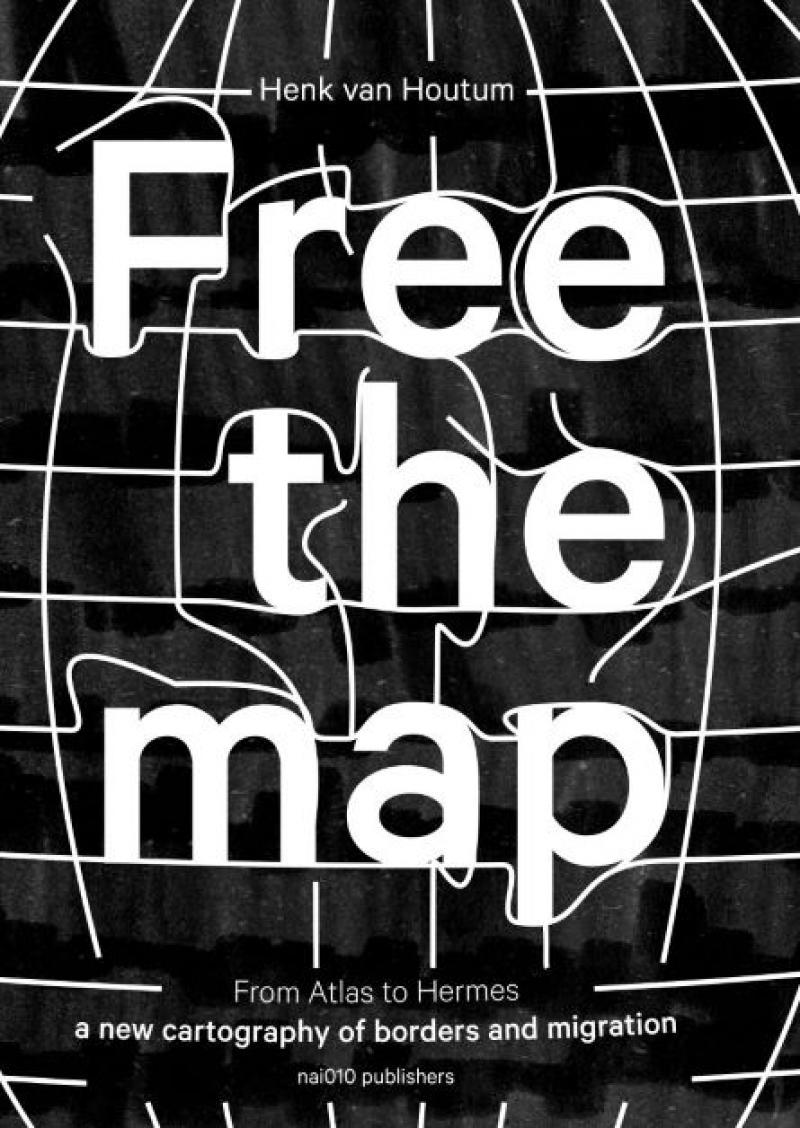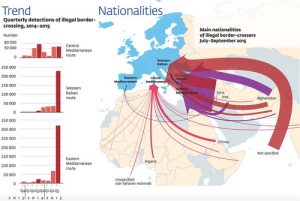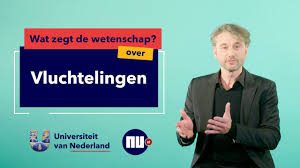Excited to announce my new book: ‘Free the Map’.
A map is a visual story of the world. It feeds our imagination and shapes our view of the world. A standard Atlas, however, predominantly tells only one story, that of the nation-state. The term ‘Atlas’ was coined by Mercator in the 16th century. He developed his world map to serve the desire for colonial navigation and appropriation of his time. From then on a standard Atlas uses this prism of the nation-state to portray the world. For centuries now, this has resulted in a world map – used in politics, education and the media – in which differences between state properties are foregrounded, people are uniformly packed into national containers and enclosed by borders, and migration is often represented as threatening invasion arrows (for the latter, see also our article on the migration map trap: https://lnkd.in/euxS-4B).
It is time to move beyond this state-centric cartography. Because, to paraphrase the surrealist painter Magritte, ‘Ceci n’est pas le monde‘. This is not the world.
Free the Map offers a radical shift in how we view and use maps. It makes a plea for a new cartographic story: a Hermes – the grandson of Atlas and the god of mobility and human connections. To this end, Rodrigo Bueno Lacy and I first discuss the huge political and societal impact of this state-centric fallacy of reducing a border to a line and migration to an arrow. Then, the book shows a large number of visually compelling alternative cartographic representations of borders and migration that humanize the map and show the world of global connections and relations.
Free the Map ends with a call to action. Various well-known artists, designers, and cartographers (Tofe Al-Obaidi, Catalogtree, Yishay Garbasz, Susanne KTofe Al-Obaidi, Catalogtree, Yishay Garbasz, Susanne Khalil Yusef, Nicolas Lambert, Sarah Mekdjian, Ruben Pater, Philippe Rekacewicz, Malkit Shoshan, Jonas Staal, Irene Stracuzzi, Annelys de Vet, Jasmijn Visser, Denis Wood) offer exciting ready-to-use, map-liberating challenges for education and public Maplabs. These briefings are also freely accessible at https://freethemap.org/
Free the Map is produced and designed by De Vormforensen.
The book can be ordered at nai010 publishers: https://lnkd.in/d5y9n9D
Latest media articles and interviews
Interview in Trouw, Dit is de meest nauwkeurige wereldkaart tot nu toe, 25 Augustus, 2023, https://archive.ph/2023.08.26-205734/https://www.trouw.nl/wetenschap/dit-is-de-meest-nauwkeurige-wereldkaart-tot-nu-toe~b612d95b/
Interview in NRC, https://www.nrc.nl/nieuws/2023/08/03/onderzoek-reddingsacties-op-de-middellandse-zee-trekken-geen-migranten-aan-a4171194, 3 Augustus, 2023
Interview in Die Furche, ”Ein Wettlauf nach unten“, 27 July 2023, https://media.licdn.com/dms/document/media/D4E1FAQGyGtfXCaB29g/feedshare-document-pdf-analyzed/0/1690455690061?e=1694649600&v=beta&t=gErT8EXLq4IDwwWyhJvF5v3YKYNMql4_hYc-fjW-W54
Interview in Reformatorisch Dagblad, ”Het is niet te rechtvaardigen dat ik wel vrij rond mag reizen en een Syrier niet”, https://archive.ph/2023.07.22-082523/https://www.rd.nl/artikel/1028802-het-is-niet-te-rechtvaardigen-dat-ik-wel-vrij-rond-mag-reizen-en-een-syrier-niet, 22 Juli 2023
Wat betekent de Europese asieldeal voor de toekomst? interview over het migratiepact met Tunesie, 9 Juni 2023, AD, https://henkvanhoutum.nl/wp-content/uploads/2023/06/Wat-betekent-de-Europese-asieldeal-voor-de-toekomst-%E2%80%98Nu-hebben-we-een-bloedige-status-quo-Binnen.pdf
Over hoe het illegale en onmenselijke grensgeweld van grenswachten en militia jegens asielzoekers aan de EU buitengrenzen gevaarlijk toeneemt, inclusief een kort statement van mij, 6 Mei 2023, AD
Legaal vluchten naar Europa, kan dat wel? Interview voor One World, 27 Februari 2023
”Hekken om migratie te stoppen langs 2048 kilometer van EU-grens, maar ze werken niet”, Interview AD en regionale bladen, 11 Februari 2023
Een hek rond Europa, Interview voor VRT, Het Kwartier, 10 Februari, 2023
”Is het rechtvaardig om asielzoekers juist in drukke provincies op te vangen?”, interview voor Dagblad Trouw, 23 Januari 2023
‘Oranjegevoel geen garantie voor acceptatie migranten‘, Interview voor VOXWEB en Radboud Recharge over de soms moeizame relatie tussen de FIFA-norm van homogene voetbalnaties en de geografische realiteit van meerdere nationaliteiten en loyaliteiten. Het voetbal biedt daarmee een interessant vergrootglas voor het integratiedebat. Waarin veel draait om respect en erkenning. Of zoals Ziyech zei na afloop van de overwinning tegen Spanje: ‘‘Ja, dat had je niet verwacht hè?”’, 14 December 2022
‘We talk about walls and fences but the hardest border is made of paper’, Interview for Radboud Recharge on some of my ongoing border research projects: the apartheid of visa paper borders, the autoimmunity of EU’s border regime, the fallacious cartography of borders and migration, and the national borders of football and bordering of football migrants, 8 December 2022
‘Vrees voor nieuwe migratiecrisis’, Interview by Boekestijn & De Wijk, BNR Nieuwsradio and for their Podcast, 26 November 2022
‘A warm welcome, for white Ukrainians – interview for VersPers ” https://henkvanhoutum.nl/wp-content/uploads/2022/11/A-warm-welcome-for-white-Ukrainians-VersPers.pdf, 7 November 2022
We praten over muren en hekken, maar de hardste grens is van papier”, interview voor Radboud Recharge, 1 november 2022
Recharge ”Grenzen dicht? Zo probeert de EU de asielzoekers al buiten de deur te houden”, 28 Oktober 2022, Interview Nederlands Dagblad
“Waarom faalt het asielbeleid” interview voor @RTLnieuws, 1 Oktober 2022
De oplossing van de asielcrisis? ‘Begin met legalisatie van migratie, Interview voor DPG (Parool, AD, Stentor, Gelderlander etc), 7 September, 2022 https://henkvanhoutum.nl/wp-content/uploads/2022/09/De-oplossing-voor-de-asielcrisis-‘Begin-met-legalisatie-van-migratie’.pdf
FOCUS, NSM MAGAZINE, interview, ”The EU is undermining its own rule of law with its border policy”, July 2022
Bueno Lacy, R and H.J. van Houtum (2022), The proximity trap: how geography is misused in the differential treatment of Ukrainian refugees to hide for the underlying global apartheid in the EUropean border regime, ASILE, 27 June 2022
Houtum, H.J. van & Uden, A. van (2021). The birth of the paper prison: the global inequality trap of visa borders. Environment and Planning C. Politics and Space https://henkvanhoutum.nl/wp-content/uploads/2021/02/2021-Rethinking-biopolitcs-pagina-20-23_pages.pdf
Houtum H.J. (2021), Beyond Borderism: Overcoming discriminative B/ordering and Othering, TESG https://onlinelibrary.wiley.com/doi/10.1111/tesg.12473
ANS (2021), Aangekaart en van de kaart?, interview over de koloniale oorsprong van de Mercator kaart, http://ans-online.nl/artikelen/aangekaart-en-van-de-kaart-2/, 20-2-2021
Boedeltje, F. & Houtum, H.J. van (2021). The lie of the wall. Peace Review. . https://www.tandfonline.com/doi/full/10.1080/10402659.2020.1836303
Campenhout, G. van & Houtum, H.J. van (2021). ”I am German when I win, but an immigrant when lose”, Theorising on the deservedness of migrants in International Football; the case of Mesut Özil. Sport in Society. https://henkvanhoutum.nl/wp-content/uploads/2021/01/I-am-German-when-we-win-but-I-am-an-immigrant-when-we-lose.pdf
Bueno Lacy, R.B.L. & H. van Houtum (2021). Death as Policy: The EU’s criminalisation of solidarity with undocumented migrants. In Expanding Boundaries Borders, Mobilities and the Future of Europe-Africa Relations. London: Routledge
Houtum, H van and A. van Uden (2020), The autoimmunity of the modern university: How its managerialism is self-harming what it claims to protect, Organization, section Speaking out https://journals.sagepub.com/doi/full/10.1177/1350508420975347
Houtum, H.J. van (2020). The rise and fall of borders. In Human territoriality. Zurich: Patrick Frey
Maite Vermeulen, H. van Houtum, en L. de Korte (2 September 2020), https://thecorrespondent.com/664/how-maps-in-the-media-make-us-more-negative-about-migrants/87812829368-c203ad78, The Correspondent
Maite Vermeulen, H. van Houtum, en L. de Korte (7 juni 2020), Zo maken kaarten in de media ons onbewust negatiever over migranten, De Correspondent, https://decorrespondent.nl/11351/zo-maken-kaarten-in-de-media-ons-onbewust-negatiever-over-migranten/494574421-f2a0eea7
Verslag over mijn recent werk: ”Door deze geograaf kijk ik nooit meer hetzelfde naar (migratie)kaarten”, in: Correspondent, 7 juli 2020, https://decorrespondent.nl/11322/door-deze-geograaf-kijk-ik-nooit-meer-hetzelfde-naar-migratie-kaarten/9c25cd14-2f71-0067-1d25-fb0e098ebc69
Houtum H. van en A. van Uden, (2020), Het samen als bedreiging en kans in de corona-tijd, Geografie, Juni. In April al online: https://geografie.nl/artikel/het-samen-als-bedreiging-en-kans-de-coronatijd
Niemand kan meer ongemerkt illegaal of ziek zijn (2020), interview in De Groene Amsterdammer, https://www.groene.nl/artikel/niemand-kan-meer-ongemerkt-illegaal-of-ziek-zijn, 22 April 2020
‘Deze kaart schreeuwt: we worden bedreigd’, Interview voor Radboud Recharge, 4 januari 2020
This maps cries out: we are being threatened, Interview for Radboud Recharge, 4 January 2020
Houtum H. van and R. Bueno Lacy (2020), The Autoimmunity of the EU’s Deadly B/ordering Regime; Overcoming its Paradoxical Paper, Iron and Camp Borders, Geopolitics, 10.1080/14650045.2020.1728743
Prize for best article
We are honoured to have received the John Urry Prize of the Journal ‘Mobilities’ for our article ”The migration map trap. On the invasion arrows in the cartography of migration” (2020) https://www.tandfonline.com/doi/full/10.1080/17450101.2019.1676031 The jury report: ”this excellent article has clear, compelling writing and images; smart, original analysis of the problems of migration cartography, wonderful analysis of a variety of maps, and very nice counter-mapping and mobile mapping examples. It is also an important intervention in policy debates around migration through unpacking the power of visual representations. It exemplifies the kinds of migration and border studies that are of interest to the Mobilities journal, building on John Urry’s interests in mapping, visual representation, and historical analysis along with critical mobility studies relevant to current political issues.” Hopefully, the prize helps in raising awareness of the power of maps and the not innocent fallacies of the invasion-like cartography of migration.
Houtum H. van and R. Bueno Lacy (2020), The migration map trap. On the invasion arrows in the cartography of migration, Mobilities, https://www.tandfonline.com/doi/full/10.1080/17450101.2019.1676031
Houtum H. van, (2019), The Janus-border of the Nomad and the Monad: An essay on the philosophy of B/ordering and Othering , in: Debating and Defining Borders: philosophical and theoretical perspectives, A. Cooper and S. Tinning (Eds)., Routledge, 181-194
Er bestaat een mondiale apartheid qua recht op mobiliteit, interview voor Vrede.be https://www.vrede.be/nieuws/er-bestaat-een-mondiale-apartheid-qua-recht-op-mobiliteit-interview-met-prof-dr-henk-van, 7 juni 2019
De muren die de wereld splijten, interview in Het Parool, 19 januari 2019
Why we avert our eyes from refugees, interview for Radboud Recharge, 13 december 2018
Voor muren moet Trump naar Europa kijken, interview in Financieel Dagblad, 26 June 2018
Vluchtelingen zijn geopolitieke handelswaar geworden,  interview in Trouw, 20 June 2018
interview in Trouw, 20 June 2018
Hoe de EU de irreguliere migratieroutes en daarmee de smokkel zelf in de hand werkt, Interview voor Vice Versa, 27 May 2018
Dood door beleid? Interview met RedPers, 1 February 2018
Hoe de wetenschap wordt uitgehold. Zeven paradoxen van academische vrijheid in het huidige onderzoeksbeleid, interview voor Vakblad voor de Wetenschap (VAWO), mei 2017
Pitch over Vluchtelingen, voor Universiteit van Nederland, 6 maart 2017
A map is a visual story of the world. It feeds our imagination and shapes our view of the world. A standard Atlas, however, predominantly tells only one story, that of the nation-state. The term ‘Atlas’ was coined by Mercator in the 16th century. He developed his world map to serve the desire for colonial navigation and appropriation of his time. From then on a standard Atlas uses this prism of the nation-state to portray the world. For centuries now, this has resulted in a world map – used in politics, education and the media – in which differences between state properties are foregrounded, people are uniformly packed into national containers and enclosed by borders, and migration is often represented as threatening invasion arrows (for the latter, see also our article on the migration map trap: https://lnkd.in/euxS-4B).
It is time to move beyond this state-centric cartography. Because, to paraphrase the surrealist painter Magritte, ‘Ceci n’est pas le monde‘. This is not the world.
Free the Map offers a radical shift in how we view and use maps. It makes a plea for a new cartographic story: a Hermes – the grandson of Atlas and the god of mobility and human connections. To this end, Rodrigo Bueno Lacy and I first discuss the huge political and societal impact of this state-centric fallacy of reducing a border to a line and migration to an arrow. Then, the book shows a large number of visually compelling alternative cartographic representations of borders and migration that humanize the map and show the world of global connections and relations.
Free the Map ends with a call to action. Various well-known artists, designers, and cartographers (Tofe Al-Obaidi, Catalogtree, Yishay Garbasz, Susanne KTofe Al-Obaidi, Catalogtree, Yishay Garbasz, Susanne Khalil Yusef, Nicolas Lambert, Sarah Mekdjian, Ruben Pater, Philippe Rekacewicz, Malkit Shoshan, Jonas Staal, Irene Stracuzzi, Annelys de Vet, Jasmijn Visser, Denis Wood) offer exciting ready-to-use, map-liberating challenges for education and public Maplabs. These briefings are also freely accessible at https://freethemap.org/
Free the Map is produced and designed by De Vormforensen.
The book will be out on January 10. It can be ordered at nai010 publishers: https://lnkd.in/d5y9n9Dw

nai010.com
Latest media articles and interviews
Interview in Trouw, Dit is de meest nauwkeurige wereldkaart tot nu toe, 25 Augustus, 2023, https://archive.ph/2023.08.26-205734/https://www.trouw.nl/wetenschap/dit-is-de-meest-nauwkeurige-wereldkaart-tot-nu-toe~b612d95b/
Interview in NRC, https://www.nrc.nl/nieuws/2023/08/03/onderzoek-reddingsacties-op-de-middellandse-zee-trekken-geen-migranten-aan-a4171194, 3 Augustus, 2023
Interview in Die Furche, ”Ein Wettlauf nach unten“, 27 July 2023, https://media.licdn.com/dms/document/media/D4E1FAQGyGtfXCaB29g/feedshare-document-pdf-analyzed/0/1690455690061?e=1694649600&v=beta&t=gErT8EXLq4IDwwWyhJvF5v3YKYNMql4_hYc-fjW-W54
Interview in Reformatorisch Dagblad, ”Het is niet te rechtvaardigen dat ik wel vrij rond mag reizen en een Syrier niet”, https://archive.ph/2023.07.22-082523/https://www.rd.nl/artikel/1028802-het-is-niet-te-rechtvaardigen-dat-ik-wel-vrij-rond-mag-reizen-en-een-syrier-niet, 22 Juli 2023
Wat betekent de Europese asieldeal voor de toekomst? interview over het migratiepact met Tunesie, 9 Juni 2023, AD, https://henkvanhoutum.nl/wp-content/uploads/2023/06/Wat-betekent-de-Europese-asieldeal-voor-de-toekomst-%E2%80%98Nu-hebben-we-een-bloedige-status-quo-Binnen.pdf
Over hoe het illegale en onmenselijke grensgeweld van grenswachten en militia jegens asielzoekers aan de EU buitengrenzen gevaarlijk toeneemt, inclusief een kort statement van mij, 6 Mei 2023, AD
Legaal vluchten naar Europa, kan dat wel? Interview voor One World, 27 Februari 2023
”Hekken om migratie te stoppen langs 2048 kilometer van EU-grens, maar ze werken niet”, Interview AD en regionale bladen, 11 Februari 2023
Een hek rond Europa, Interview voor VRT, Het Kwartier, 10 Februari, 2023
”Is het rechtvaardig om asielzoekers juist in drukke provincies op te vangen?”, interview voor Dagblad Trouw, 23 Januari 2023
‘Oranjegevoel geen garantie voor acceptatie migranten‘, Interview voor VOXWEB en Radboud Recharge over de soms moeizame relatie tussen de FIFA-norm van homogene voetbalnaties en de geografische realiteit van meerdere nationaliteiten en loyaliteiten. Het voetbal biedt daarmee een interessant vergrootglas voor het integratiedebat. Waarin veel draait om respect en erkenning. Of zoals Ziyech zei na afloop van de overwinning tegen Spanje: ‘‘Ja, dat had je niet verwacht hè?”’, 14 December 2022
‘We talk about walls and fences but the hardest border is made of paper’, Interview for Radboud Recharge on some of my ongoing border research projects: the apartheid of visa paper borders, the autoimmunity of EU’s border regime, the fallacious cartography of borders and migration, and the national borders of football and bordering of football migrants, 8 December 2022
‘Vrees voor nieuwe migratiecrisis’, Interview by Boekestijn & De Wijk, BNR Nieuwsradio and for their Podcast, 26 November 2022
‘A warm welcome, for white Ukrainians – interview for VersPers ” https://henkvanhoutum.nl/wp-content/uploads/2022/11/A-warm-welcome-for-white-Ukrainians-VersPers.pdf, 7 November 2022
We praten over muren en hekken, maar de hardste grens is van papier”, interview voor Radboud Recharge, 1 november 2022
Recharge ”Grenzen dicht? Zo probeert de EU de asielzoekers al buiten de deur te houden”, 28 Oktober 2022, Interview Nederlands Dagblad
“Waarom faalt het asielbeleid” interview voor @RTLnieuws, 1 Oktober 2022
De oplossing van de asielcrisis? ‘Begin met legalisatie van migratie, Interview voor DPG (Parool, AD, Stentor, Gelderlander etc), 7 September, 2022 https://henkvanhoutum.nl/wp-content/uploads/2022/09/De-oplossing-voor-de-asielcrisis-‘Begin-met-legalisatie-van-migratie’.pdf
FOCUS, NSM MAGAZINE, interview, ”The EU is undermining its own rule of law with its border policy”, July 2022
Bueno Lacy, R and H.J. van Houtum (2022), The proximity trap: how geography is misused in the differential treatment of Ukrainian refugees to hide for the underlying global apartheid in the EUropean border regime, ASILE, 27 June 2022
Houtum, H.J. van & Uden, A. van (2021). The birth of the paper prison: the global inequality trap of visa borders. Environment and Planning C. Politics and Space https://henkvanhoutum.nl/wp-content/uploads/2021/02/2021-Rethinking-biopolitcs-pagina-20-23_pages.pdf
Houtum H.J. (2021), Beyond Borderism: Overcoming discriminative B/ordering and Othering, TESG https://onlinelibrary.wiley.com/doi/10.1111/tesg.12473
ANS (2021), Aangekaart en van de kaart?, interview over de koloniale oorsprong van de Mercator kaart, http://ans-online.nl/artikelen/aangekaart-en-van-de-kaart-2/, 20-2-2021
Boedeltje, F. & Houtum, H.J. van (2021). The lie of the wall. Peace Review. . https://www.tandfonline.com/doi/full/10.1080/10402659.2020.1836303
Campenhout, G. van & Houtum, H.J. van (2021). ”I am German when I win, but an immigrant when lose”, Theorising on the deservedness of migrants in International Football; the case of Mesut Özil. Sport in Society. https://henkvanhoutum.nl/wp-content/uploads/2021/01/I-am-German-when-we-win-but-I-am-an-immigrant-when-we-lose.pdf
Bueno Lacy, R.B.L. & H. van Houtum (2021). Death as Policy: The EU’s criminalisation of solidarity with undocumented migrants. In Expanding Boundaries Borders, Mobilities and the Future of Europe-Africa Relations. London: Routledge
Houtum, H van and A. van Uden (2020), The autoimmunity of the modern university: How its managerialism is self-harming what it claims to protect, Organization, section Speaking out https://journals.sagepub.com/doi/full/10.1177/1350508420975347
Houtum, H.J. van (2020). The rise and fall of borders. In Human territoriality. Zurich: Patrick Frey
Maite Vermeulen, H. van Houtum, en L. de Korte (2 September 2020), https://thecorrespondent.com/664/how-maps-in-the-media-make-us-more-negative-about-migrants/87812829368-c203ad78, The Correspondent
Maite Vermeulen, H. van Houtum, en L. de Korte (7 juni 2020), Zo maken kaarten in de media ons onbewust negatiever over migranten, De Correspondent, https://decorrespondent.nl/11351/zo-maken-kaarten-in-de-media-ons-onbewust-negatiever-over-migranten/494574421-f2a0eea7
Verslag over mijn recent werk: ”Door deze geograaf kijk ik nooit meer hetzelfde naar (migratie)kaarten”, in: Correspondent, 7 juli 2020, https://decorrespondent.nl/11322/door-deze-geograaf-kijk-ik-nooit-meer-hetzelfde-naar-migratie-kaarten/9c25cd14-2f71-0067-1d25-fb0e098ebc69
Houtum H. van en A. van Uden, (2020), Het samen als bedreiging en kans in de corona-tijd, Geografie, Juni. In April al online: https://geografie.nl/artikel/het-samen-als-bedreiging-en-kans-de-coronatijd
Niemand kan meer ongemerkt illegaal of ziek zijn (2020), interview in De Groene Amsterdammer, https://www.groene.nl/artikel/niemand-kan-meer-ongemerkt-illegaal-of-ziek-zijn, 22 April 2020
‘Deze kaart schreeuwt: we worden bedreigd’, Interview voor Radboud Recharge, 4 januari 2020
This maps cries out: we are being threatened, Interview for Radboud Recharge, 4 January 2020
Houtum H. van and R. Bueno Lacy (2020), The Autoimmunity of the EU’s Deadly B/ordering Regime; Overcoming its Paradoxical Paper, Iron and Camp Borders, Geopolitics, 10.1080/14650045.2020.1728743
Prize for best article
We are honoured to have received the John Urry Prize of the Journal ‘Mobilities’ for our article ”The migration map trap. On the invasion arrows in the cartography of migration” (2020) https://www.tandfonline.com/doi/full/10.1080/17450101.2019.1676031 The jury report: ”this excellent article has clear, compelling writing and images; smart, original analysis of the problems of migration cartography, wonderful analysis of a variety of maps, and very nice counter-mapping and mobile mapping examples. It is also an important intervention in policy debates around migration through unpacking the power of visual representations. It exemplifies the kinds of migration and border studies that are of interest to the Mobilities journal, building on John Urry’s interests in mapping, visual representation, and historical analysis along with critical mobility studies relevant to current political issues.” Hopefully, the prize helps in raising awareness of the power of maps and the not innocent fallacies of the invasion-like cartography of migration.
Houtum H. van and R. Bueno Lacy (2020), The migration map trap. On the invasion arrows in the cartography of migration, Mobilities, https://www.tandfonline.com/doi/full/10.1080/17450101.2019.1676031
Houtum H. van, (2019), The Janus-border of the Nomad and the Monad: An essay on the philosophy of B/ordering and Othering , in: Debating and Defining Borders: philosophical and theoretical perspectives, A. Cooper and S. Tinning (Eds)., Routledge, 181-194
Er bestaat een mondiale apartheid qua recht op mobiliteit, interview voor Vrede.be https://www.vrede.be/nieuws/er-bestaat-een-mondiale-apartheid-qua-recht-op-mobiliteit-interview-met-prof-dr-henk-van, 7 juni 2019
De muren die de wereld splijten, interview in Het Parool, 19 januari 2019
Why we avert our eyes from refugees, interview for Radboud Recharge, 13 december 2018
Voor muren moet Trump naar Europa kijken, interview in Financieel Dagblad, 26 June 2018
Vluchtelingen zijn geopolitieke handelswaar geworden,  interview in Trouw, 20 June 2018
interview in Trouw, 20 June 2018
Hoe de EU de irreguliere migratieroutes en daarmee de smokkel zelf in de hand werkt, Interview voor Vice Versa, 27 May 2018
Dood door beleid? Interview met RedPers, 1 February 2018
Hoe de wetenschap wordt uitgehold. Zeven paradoxen van academische vrijheid in het huidige onderzoeksbeleid, interview voor Vakblad voor de Wetenschap (VAWO), mei 2017
Pitch over Vluchtelingen, voor Universiteit van Nederland, 6 maart 2017


